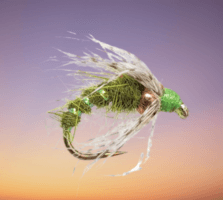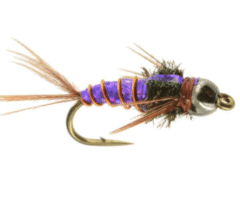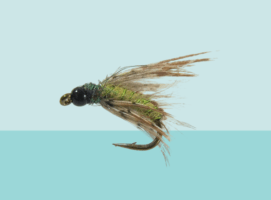Your cart is currently empty!
Bjorn’s Baddest Caddis Brown fly
Bjorn’s Baddest Caddis Brown fly : trout fishing flies The Bjorn’s Baddest Caddis Brown fly represents an innovative evolution in caddis patterns, designed by Bjorn Ostby. This specialized pattern features a unique combination of soft fibers and natural materials that create a highly effective imitation of a caddis pupa frantically swimming toward the surface. The…
Description
Bjorn’s Baddest Caddis Brown fly : trout fishing flies
The Bjorn’s Baddest Caddis Brown fly represents an innovative evolution in caddis patterns, designed by Bjorn Ostby. This specialized pattern features a unique combination of soft fibers and natural materials that create a highly effective imitation of a caddis pupa frantically swimming toward the surface. The design has been specifically engineered to simulate natural movement and create an irresistible presentation of Bjorn’s Baddest Caddis Brown fly, making it particularly effective across various water conditions. The combination of life-like qualities and attractive tie creates a highly versatile pattern that consistently produces results with selective trout. For anglers seeking a reliable option, Bjorn’s Baddest Caddis Brown fly is the perfect choice.
The pattern’s effectiveness stems from its carefully engineered components:
The effectiveness of Bjorn’s Baddest Caddis Brown fly lies in its balanced construction, which attracts fish in different environments.
- Premium curved hook
- Soft throat fibers
- Brown dubbing blend
- Precise body proportions
- Segmented design
- Durable construction
- Realistic profile
- Enhanced movement
- Modern techniques
- Natural appearance
Technical Specifications
Hook Characteristics:
- Premium curved hook
- Available sizes: 12-16
- Standard wire construction
- Down-eye design
- Chemically sharpened point
- Wide gape configuration
- Bronze finish
- Optimal hook strength
- Enhanced penetration design
- Perfect size-to-weight ratio
Material Properties:
- Selected brown dubbing
- Soft fiber materials
- Quality synthetics
- Enhanced durability
- Mixed materials
- Modern construction
- Color-fast characteristics
- Movement enhancement
- Profile consistency
- Natural appearance
Construction and Tying Process
The pattern’s success relies on precise construction methods:
Many anglers have reported success using Bjorn’s Baddest Caddis Brown fly in various fishing conditions, highlighting its versatility.
- Balanced proportions
- Strategic fiber placement
- Graduated body tapering
- Reinforced connections
- Material integration
- Enhanced durability features
- Proper dubbing application
- Segmentation creation
- Profile consistency
- Movement optimization
Fishing Applications and Techniques
Presentation Methods:
When using Bjorn’s Baddest Caddis Brown fly, consider experimenting with your retrieve speed and depth to determine what works best.
- Dead drift
- Short strips
- Multiple drift angles
- Depth control
- Pattern placement
- Current seam fishing
- Structure targeting
- Cross-current drifts
- Action variation
- Traditional nymphing
Specialized Applications:
In clearer waters, Bjorn’s Baddest Caddis Brown fly can effectively mimic natural caddis life cycles, increasing your chances of a catch.
- Caddis emergences
- Technical water
- Spring creeks
- Tailwaters
- Clear water
- Selective trout
- Evening fishing
- Match-the-hatch
- Subsurface feeding
- High-pressure situations
Seasonal Effectiveness?Spring Performance:
During spring, using Bjorn’s Baddest Caddis Brown fly can significantly enhance your fishing experience, especially with rising fish.
- Early caddis hatches
- Water level variations
- Mixed techniques
- Weather changes
- Pattern selection
- Temperature increases
- Fish movement
- Feeding windows
- Emergence timing
- Hatch matching
Summer Strategy:
As summer approaches, Bjorn’s Baddest Caddis Brown fly remains a staple for many anglers looking to capture elusive trout.
- Evening hatches
- Morning activity
- Temperature changes
- Feeding patterns
- Oxygen levels
- Light penetration
- Fish behavior
- Water conditions
- Current seams
- Structure targeting
Fall Applications:
For fall applications, Bjorn’s Baddest Caddis Brown fly can effectively target fish during late evening hatches.
- Late season hatches
- Cooling waters
- Changed light conditions
- Transitional periods
- Selective takes
- Pattern visibility
- Fish location
- Temperature drops
- Migration patterns
- Feeding windows
Winter Tactics:
In winter, Bjorn’s Baddest Caddis Brown fly offers an effective option for anglers targeting deep pools.
- Limited opportunities
- Midday fishing
- Slow presentations
- Temperature considerations
- Pattern visibility
- Fish holding patterns
- Oxygen levels
- Light penetration
- Feeding windows
- Cold water techniques
Habitat and Water Types?Water Applications:
For various habitats, Bjorn’s Baddest Caddis Brown fly excels in both still and flowing waters.
- Spring creeks
- Tailwaters
- Mountain streams
- Deep runs
- Clear pools
- Structure areas
- Current seams
- Drop-offs
- Holding water
- Pocket water
Specialized Environments:
- Technical waters
- Deep channels
- Freestone rivers
- Boulder pockets
- Complex currents
- Bank edges
- Channel drops
- Boulder fields
- Undercut banks
- Current breaks
Target Species and Behavior?Primary Species:
- Brown Trout
- Rainbow Trout
- Brook Trout
- Cutthroat Trout
- Grayling
- Selective Trout
- Technical Water Species
- Subsurface Feeders
Feeding Behaviors:
- Natural inspection
- Selective takes
- Pattern recognition
- Territorial behavior
- Opportunistic takes
- Selective feeding
- Strike triggers
- Visual stimulation
- Lateral line response
- Competitive feeding
Rigging Recommendations?Leader Setup:
- 9-12 foot leaders
- 5X-6X tippet
- Tapered leaders
- Fluorocarbon options
- Loop-to-loop connections
- Proper presentation
- Adequate stiffness
- Knot strength
- Breaking strain
- Abrasion resistance
Presentation Options:
- Single fly rigs
- Double fly rigs
- Multiple fly systems
- Traditional methods
- Modern techniques
- Line matching
- Leader design
- Tippet selection
- Depth control
- Weight adjustment
Professional Applications?Guide Usage:
- Client-friendly pattern
- Proven success rates
- Consistent performance
- Easy presentation
- Multiple techniques
- Teaching tool
- Confidence pattern
- Versatile applications
- Durability
- Hook-up ratio
Competition Usage:
- Tournament proven
- Technical water success
- Pressure adaptation
- Quick-change capability
- Consistent performance
- Depth control
- Pattern rotation
- Size variation
- Color selection
- Presentation options
Care and Maintenance?Post-Fishing Care:
- Thorough drying
- Material grooming
- Hook point inspection
- Fiber maintenance
- Material preservation
- Storage preparation
- Pattern inspection
- Shape verification
- Performance testing
- Movement checking
Storage Requirements:
- Dry environment
- UV protection
- Separate compartments
- Regular inspection
- Moisture prevention
- Temperature control
- Light protection
- Ventilation needs
- Box organization
- Inventory management
Advanced Fishing Methods?Presentation Techniques:
- Traditional nymphing
- Depth control
- Strike detection
- Drift management
- Current reading
- Structure approach
- Pattern tracking
- Recovery methods
- Angle optimization
- Speed control
Water Reading:
- Current understanding
- Depth assessment
- Structure location
- Fish holding areas
- Presentation angles
- Feeding lanes
- Travel routes
- Rest areas
- Temperature breaks
- Current seams
Environmental Considerations?Conservation Features:
- Sustainable materials
- Durable construction
- Catch-and-release friendly
- Minimal environmental impact
- Eco-conscious design
- Material selection
- Ethical considerations
- Resource protection
- Species conservation
- Environmental awareness
Material Selection:
- Responsible sourcing
- Quality components
- Mixed elements
- Ethical production
- Sustainable practices
- Environmental impact
- Material longevity
- Waste reduction
- Local materials
- Eco-conscious design
Additional information
| Hook size | 10, 12, 14, 16, 18, 20, 22 |
|---|---|
| Hook type | Barbed Hooks, Barbless Hooks |







